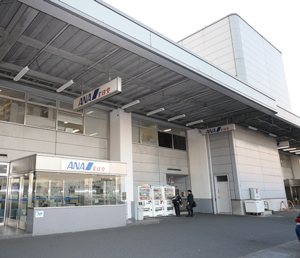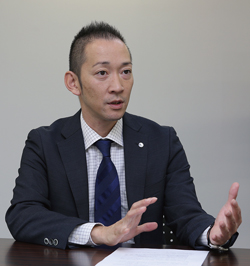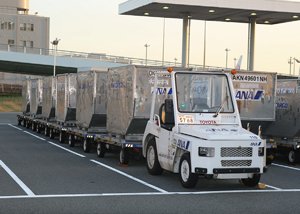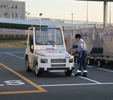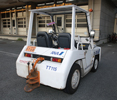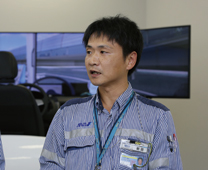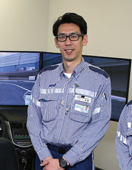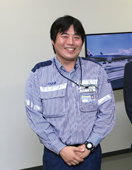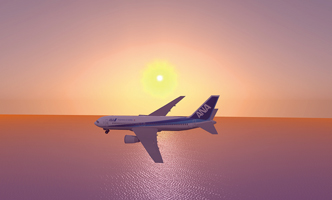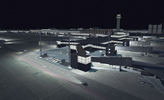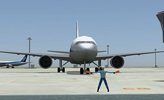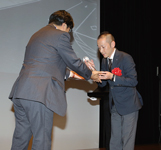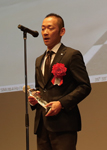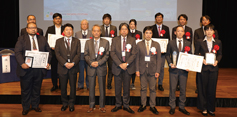|
Currently, the company is engaged in services including freight operation of air cargo for all flights of ANA that nearly amounts to 400, AIRDO, and SFJ; and handling and freight service of mails as its main service mainly in the 2nd Terminal of Haneda Airport. Based in its head office and Airport Office (both of which are in Ota-ku, Tokyo), about 230 employees (as of Nov. 2017) are working 24 hours 365 days on shifts. Among them, Airport Office accommodates Cargo and Mail Department that provides work-site operation, and Safety and Quality Management Department that supports its safety and management. The head office accommodates General Affairs Department.
First, Cargo and Mail Department consists of Transportation Section 1 - 3 that take charge of transportation and loading/unloading of cargo in the airport; Postal Section in charge of transportation of domestic mails and sorting, stowing and delivering mails; and Administration Section that coordinates works of these sections and allocates activities. In particular, each of Transportation Section 1 - 3 consists of 5 groups, each of which has more than 20 members. In these groups, in order to maintain the shift-work system mentioned above, a large number of senior workers (older than 60) play an important role by demonstrating their abilities effectively. Mr. Nobuyuki Endo, Assistant General Manager of Cargo and Mail Department and Leader of Administration Section that leads fixation of work system of sections and inspection of work operation in consideration of productivity, expresses one of the recent characteristics of the Department.
In contrast, Safety and Quality Management Department takes charge of safety management for work-site operation that requires driving vehicles in the special environment as well as new employee training. For example, they perform activities to prevent accidents for their company employees using accident cases examples of other companies. They also give lectures on basic knowledge required at their occupations as a preliminary stage for new employees hired almost every month to take practical training after being positioned at Cargo and Mail Department. Mr. Ryusuke Matsuda, Leader of Safety and Quality Section, Safety and Quality Management Department who is responsible for policy development of the Department and its operation, tries to share information by holding regular meetings on safety with the staff of other companies who are involved with various services in the same Haneda Airport. Mr. Hirofumi Nitta, Manager of Safety and Quality Section of the same Department, instructs new employees on basic knowledge that is necessary in working in the airport. The areas of knowledge include those of vehicles they use and airplanes.
Investigation for Possibility of Utilizing ICT for Efficient Cargo Transportation
|
A key to performing cargo transportation smoothly and precisely, and securing punctual flights of airplanes is "Controller". This transmits instructions of cargo transportation based on operation status of all departure and arrival flights of the airline companies they are entrusted with. Its services are roughly divided as follows:
1) "Departure Controller" to confirm the load instruction sheet for every departure flight, allot operators properly, and instructs transportation and loading.
2) "Arrival Controller" to instruct work operators who have finished operation on the departure flights about PBB connection of arrival flights, as well as unloading and transportation of cargo through wireless communication while monitoring the conditions of arrival flights.
3) "Check Controller" to confirm if there is any omission of instruction about placing operators or the progress of operation, and sum up work-site operation such as response to irregular events.
|
|
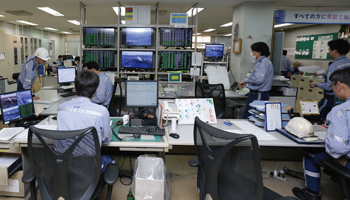 |
Controller operation for cargo transportation to support
punctual flights (within the airport office) |
|
"There is huge amount of information (circulating) in the work in the airport. (To perform Controller tasks,) we organize information to communicate with 30 - 40 members (of work operators) at the same time using only wireless." Moreover, much part of the work still depends on analog methods such as paper-based communication, says Mr. Endo. In order to improve its efficiency, they are searching for possibility of utilizing Information and Communications Technology (ICT) such as smartphones and tablet terminals. However, since the system itself belongs to respective airline companies and because trustee companies of the services across the country are involved, Meiwa Sky Support is making research on the present situation of the concerned operation and effect of electronization. After that they would like to attempt an approach that is beneficial to all concerned people, according to Mr. Matsuda.
Approach to Building Up DS for Training to Drive Vehicles in the Airport
Most of all employees are required to drive vehicles for their jobs. However, nearly 80 % of new employees are unexperienced drivers or "paper drivers" (licensed drivers who do not drive). Furthermore, since all the vehicles including towing tractors the company uses are left-hand drive, the first thing they do after joining the company is to get used to driving. In addition, the company has been giving high priority to hiring elderly people. They don't have any problem with driving, but seem to have trouble memorizing the routes in the airport. Then an idea has been aroused that having a driving simulator would be great, which allows them not only to get used to driving vehicles but also to learn the routes, says Mr. Torigoe, President. "(New employee training) has been offered by one-to-one guidance because it is accompanied by vehicle driving. However, it is not effective to teach driving (in such a system) before teaching actual work. If there were a simulator, one instructor would probably be able to instruct plural trainees (at the previous stage before being assigned to work-site operation sections)."
Under such an idea, while searching for a simulator that met their own needs on the Internet in summer 2016, they reached FORUM8's "UC-win/Road Drive Simulator (DS)" as well as other companies' products that provide similar technologies. After having asked various inquiries to each of them without preliminary knowledge about VR, President Torigoe and Mr. Matsuda visited FORUM8 because of our careful explanation and agreement of conditions such as the price. Experiencing different kinds of simulators on display, President Torigoe got the feeling that this would be satisfactory.
|
Moreover, based on the offer of the FORUM8 staff member in charge saying "We would like to cooperate with you so that we can meet your needs, though we have never treated DS for driving special vehicles in the airport." The company started to show their request around November. While taking the cost accompanying it into consideration, they worked out the details of the range of airport for VR to create, accuracy of video image, and vehicles to set, then shot video. Based on the video image, they started to create VR. By the end of Feb 2017, a simulator for educational training was developed for driving special vehicles, reflecting the particular environment of Haneda Airport and its specific traveling rules, using VR based on UC-win/Road DS. Beginning with the unveiling at the training for mid-career employees held in March, they started full-scale operating of the simulator from the instruction and training for new employees including new graduates in April.
|
|
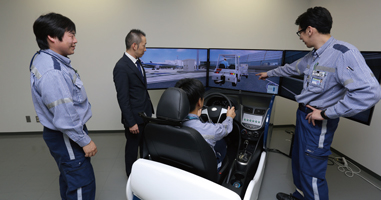 |
VR simulator using UC-win/Road that allows realistic experience of
cargo transportation in the airport |
|
The company also applied the created VR data for "the 16th 3D-VR Simulation Contest on Cloud" (sponsored by FORUM8). They won Grand Prix (the highest award) at its final judgment held on Day1 (Nov. 15) of "the 11th FORUM8 Design Festival 2017-3Days+Eve".
Evaluation of DS and Next Target
"(Though we had thought that the VR space would be in a bit lower reality,) it was greater than we imagined, being just as actual (as the real world). So, we felt for real that this was completely usable". In President Torigoe’s opinion, using this simulator to have new employees being able to drive to some extent in advance will lead to avoidance of accidents and reduction of training time. Besides, Mr. Nitta mentions its reputation from elderly employees that it was useful in learning routes.
In the sense of reproductivity, Mr. Matsuda highly evaluated it for its correct representation of the rules specific to the airport as well as road markings, and Mr. Endo also for its representation of traveling characteristics of special vehicles. They also consider its effective application to explanation of dangerous scenes etc. Additionally, Mr. Matsuda expects it to develop to a tool that contributes to improvement in safety for both new and experienced employees, as well as for instructing new employees, by including the past accident cases, scenes where an airplane and a vehicle cross, and grading function.
Based on such needs, they are willing to update the VR data continuously by adding diverse information, as President Torigoe says.
"In the future, we would like to reach the level that the VR contains simulation of operation to connect mechanical equipment to the high lift loader, as well as potentially dangerous minor incident or irregular cases in the past."
Grand Prix in the 16th 3D-VR Simulation Contest on Cloud
"Educational training using Haneda Airport VR simulator"
|
|
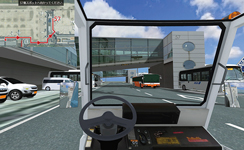 |
|
VR data for the driving simulator aiming for training safe vehicle driving with particular vehicle traveling rules and environment inside Haneda Airport, which is different from general roads. The data represents not only the roads and facilities within the airport but also special vehicles and airplanes coming and going. It is utilized for instruction and training of dangerous places and check points in driving vehicles.
|
|
|
System outline
Allows experiencing scenario of driving safely and stopping at the given position in the particular environment of airport, where the driver confirms the destination by the number put on the bridge, or waits for an airplane to pass.
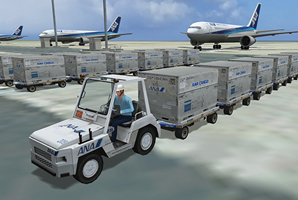 |
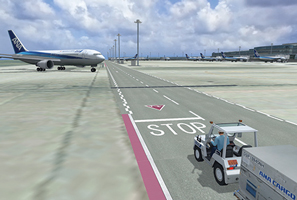 |
DS was introduced to practice driving in the particular environment of
the airport, where various special
vehicle travel, no signs and direction boards are installed, and its own
original traffic rules are provided.
DS helps to memorize routes to destinations, or confirm the check points
such as stop positions. |
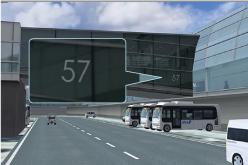 |
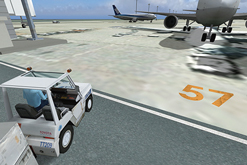 |
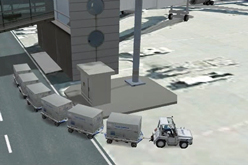 |
Destination is confirmed by the number etc. put on the bridge and such.
Destination is
confirmed in this way because there are many places with similar landscape
in the airport |
Travel safely, and stop at the destination. |
|
